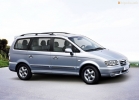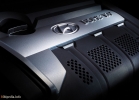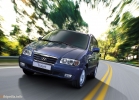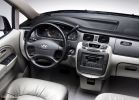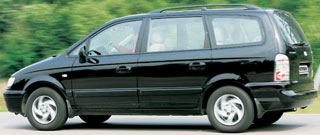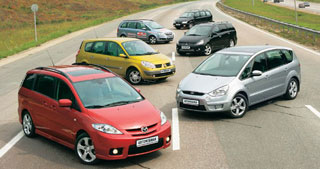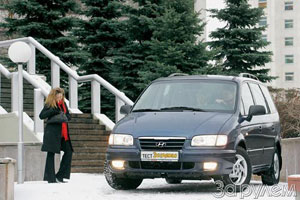Hyundai Trajet test drive since 2004 minivan
Against the stream
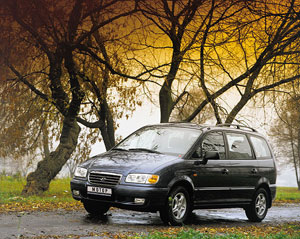 In the range of Hyundai models, which overlaps almost all market sectors, until recently there was no mini-wan. But in 1999, in European car dealerships, the company lit up the Trajet model. Last year, she appeared on sale in almost all main markets (except perhaps the North American). Including in Russia ...
In the range of Hyundai models, which overlaps almost all market sectors, until recently there was no mini-wan. But in 1999, in European car dealerships, the company lit up the Trajet model. Last year, she appeared on sale in almost all main markets (except perhaps the North American). Including in Russia ... The fit of Deja-vu somewhere I already saw this mini-van. Mentally sorting out: Opel, Volkswagen, Mazda?. No, not that ... Ba, but here is the Hyundai logo on the false radiator grille!
With its outlines, Trajet is similar to almost all modern European mini-wenes at once. The general style does not cause any negative emotions, but also positive ones. They created a TRAJET in the European design studio Hyundai (near Frankfurt) as an inexpensive and relatively mass car from here and the international appearance.
Inside Trajet is no more original than outside. The kingdom of gray plastic and gray in the red speck of velor. There’s nothing to catch on the look, but everything is very functional and convenient. There are a huge number of cup holders and all kinds of containers and shelves. In the front doors there are large plastic pockets with a special stamping, which easily fit a 1.5-liter bottle. Before the front passenger, as many as two glove boxes. The upper one has a very modest size, but its cover when opening turns into a kind of mini-old with two cup holders. The lower performs only its direct functions and does not shine in size either. Folding tables are built in the backs of the front seats (as in airplanes); The tables become folded, and the backs of the seats of the second and third rows. Yes, yes, the third, the car is seven -seater (2+3+2)! While most automakers seeks to reduce the dimensions of their mini-wenes, Hyundai went against the current, making a full-size model ...
There are plenty of places (and heads) in the first and second rows. The third row is more suitable for children. Widely opening doors and a fairly low floor provide a convenient landing and ease. The floor is absolutely even, due to which great opportunities for transformation of the salon are opened. In the original version (seven seats), the luggage volume is 523 liters. Since the cargo compartment is vertical, the luggage holds a special net so that it does not fall out when opening the door. If you remove all the seats, except for the front ones, we get a cargo compartment with a volume of 3178 liters. Plus, intermediate options, including the ability to expand the front seats by 180 degrees.
The procedure for eliminating unnecessary seats only looks very simple, in fact you will have to tinker. To get to the mounting mechanisms, you need to tilt the backs far forward, for this it is necessary to remove the headrests. Yes, and the seats weigh decently. However, with a similar divergence of theory and practice, you are faced with almost all mini-wen ...
The seats are moderately tough and have mechanical adjustments in the longitudinal direction and along the corner of the back of the back (including seats of the second row), and the driver's height is also set in height. The landing is slightly different from the passenger and almost does not give out that you are driving a small but bus. The sighting in general is worthy of praise, only in the salon mirror the headrests of the back rows loom, but here large external mirrors come to the rescue. The dashboard is also easily observed. It only has the most necessary: \u200b\u200ba speedometer, a tachometer, fuel level and engine temperature. The rest of the information is reported by the relevant light bulbs if there is a problem suddenly.
The governing bodies are located in ordinary places and are quite convenient, with the exception of unusual Japanese steering wheel switches, which manage, it seems, to everyone except microclimate. The outer light is turned on by the rotation of the head of the left lever, and first is near. The distant one turns on another click on the oncoming trip, you have to remove the hand from the steering wheel, and even follow the clicks so as not to turn off the light at all.
I had to tinker with fog lights. The button with the corresponding symbol was found on the right side of the central console. I press any effect, the same thing again. I go around the car, it turned out to be the rear foglights. And where is the front button? The photographer helped out: having a French car, he quickly found a small rotating ring on his left item, which is responsible for the front fog lights. In the same way (the ring on the right lever), the duration of the pause is regulated during the operation of the wipers. By the way, the rear janitor can also work in intermittent mode.
Microclimate control is carried out by means of two comfortable rotating handles covered with a thin layer of rubber. One controls the temperature, the other in the speed of the air flow. The choice of stream distribution is made by buttons with understandable symbols ...
By the way, a few words about the name of the car will be by the way. The letter combination of Jet (Jat) is striking in English now in English call small jet aircraft designed for the quick and comfortable movement of several passengers over long distances. The version is tempting, but incorrect. The name Trajet should be read in French (trash, with stress on the last syllable), but it means highway, road, travel ....
On the move, Trajet quite confirms the fidelity of the French version of the name, there is nothing reactive in its behavior, at least with a two-liter engine (there is an option with a more powerful and more powerful 2.7-liter engine Delta V6). In addition, 2 l of the motor has a rather strange characteristic. With an obvious lack of moment on the bottom, the engine is completely not steep. Even at starting with slipping after the wheels are caught a reliable clutch with the road, the car is in no hurry to accelerate. At the same time, the engine evenly increases the speed to 5000, then the speed of the speed set drops markedly, so it makes no sense to twist the motor further.
The transmission of the boxes is short and do not cling to each other. Even after switching up at 4500-5000 rpm. A noticeable failure is felt, and the motor again has to get out of the bottom. It seems that the gear rates of the transmission were selected under another engine. Yes, and the mechanism of selection of transmissions could work honestly. The long lever of the five -speed checkpoint has a large free move not only on neutrals, but also with the transmission turned on. It’s not immediately possible to get into the first from above as if this is interfered with some kind of lock. To unlock, you need to download the lever on the neutral to the right to the right, but in the traffic jam, with frequent switching 1-2-1 -... This is not too convenient to make unnecessary movements, and at this time someone manages to insert their car in front of the nose.
On the other hand, the mini-ven by definition is not intended for competitions in dynamics. And let Trajet with 2 liters of the engine accelerate from zero to hundreds in 13.1 seconds. This indicator is important on paper. On the real highway, it is more significant whether the car will be able to quickly dial a hundred, say, from 50 km/h for overtaking. And Trajet copes with this task ...
I liked the steering. The amplifier has a progressive characteristic, so that during parking you do not have to strain, and with an increase in speed, the steering wheel is poured with reactive effort and becomes quite informative even in the near -headed zone. Brakes with the optimal combination of the effort on the pedal and its movement. Despite the lack of ABS, they perfectly coped with their duties even on slippery coating (special thanks to Michelin tires). Clutch without comments.
Suspension (in front of Macpherson, behind an independent rarity for mini-wenes of this class) provides the better comfort, the more the car is loaded, an empty Trajet rides a little on bumps. Brains in corners within reasonable limits. Most liked the behavior of a mini-wen on an empty and direct suburban highway. When moving even at high speeds in the cabin, it is quiet and comfortable, neither the noise of the engine, nor the noise of the wind, and only on the rough coating there is a rumble of tires ...
Korean automakers, including Hyundai Motor Co., managed to form an opinion about its products as a completely modern, reliable and at the same time relatively inexpensive (the latter determines the entire category of buyers who turn their eyes to Korean machines). In addition, one should not forget that in this case we are talking about a mini-wen car by determining the utilitarian. Such machines are bought as necessary, for considerations of practicality, and not an image. The creators of Trajet studied the experience of competitors well. Let the car not shine with originality, but for each of the main parameters it is at the level. And in their combination, including the most practical cost, above many.
Alexander Nadens

